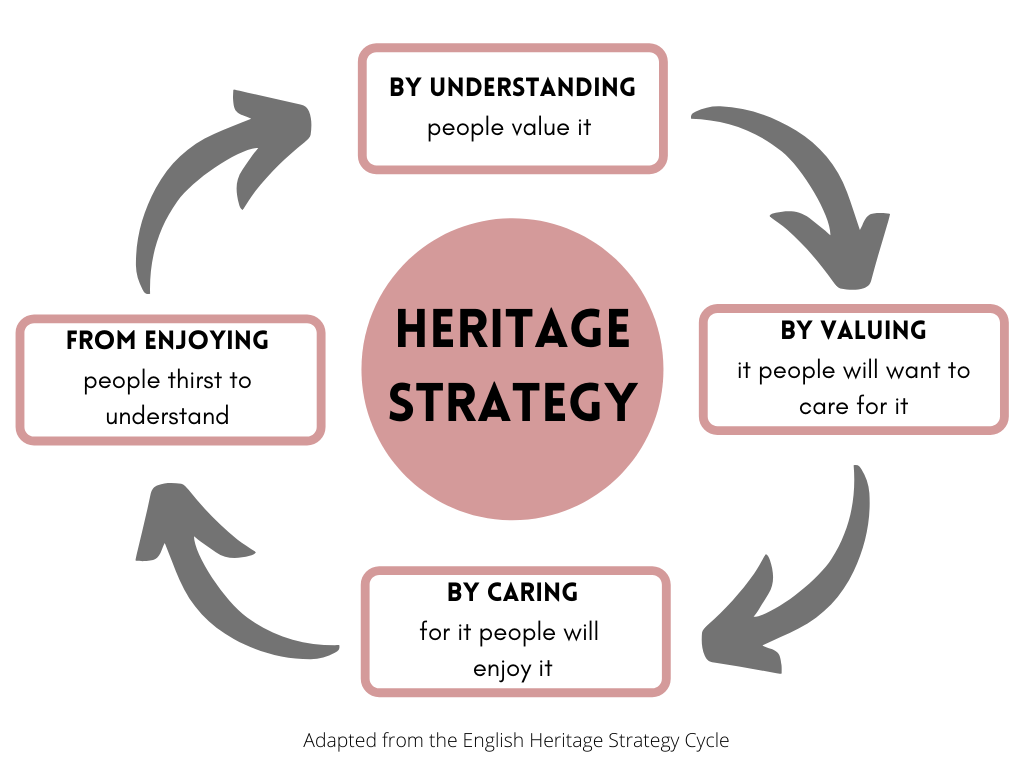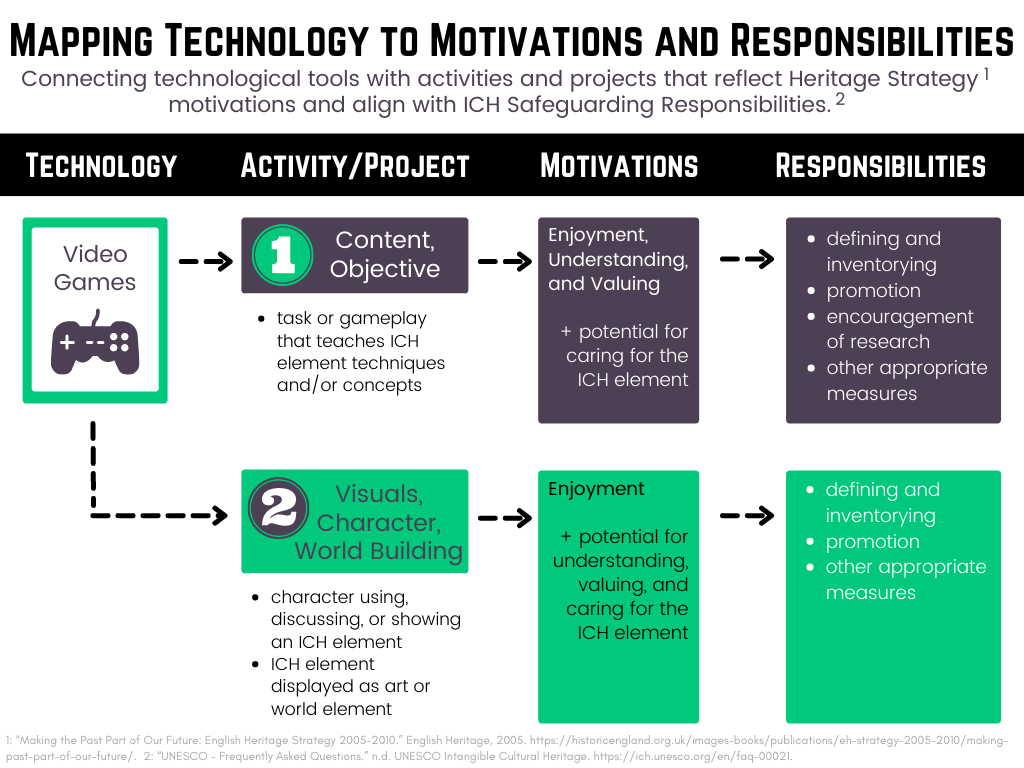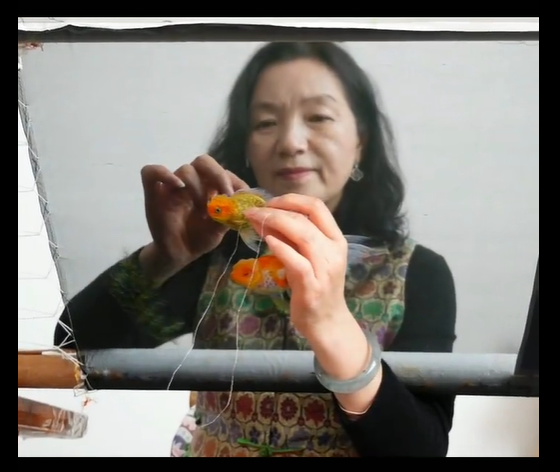In an increasingly virtual work environment, digital technology is becoming a standard tool for creative industries. Cultural heritage work is no different. A broad variety of tools are being used to safeguard cultural heritage sites and objects, from partnering 3D modeling, drones and artificial intelligence for a preservation project on the Great Wall of China, to virtual reality being used to replicate and recreate the Dunhuang Caves. With the growing attention for intangible cultural heritage (ICH), it is important to explore what digital tools are being used for fulfilling intangible cultural heritage safeguarding responsibilities, their motivations, and what opportunities exist for other projects and their practitioners.
Challenges for Identifying and Implementing Tools
Safeguarding responsibilities for ICH includes several activities. Countries who ratified UNESCO’s Convention for Safeguarding of the Intangible Cultural Heritage (Convention) are charged for safeguarding ICH elements as delineated through four categories of responsibility shown in Figure 1:
Defining and inventorying ICH instantiations
Adopting policies and establishing institutions that monitor and promote ICH
Encouraging research of ICH
Taking additional appropriate measures
Importantly, these activities are to be grounded through the inclusion of ICH elements’ home communities. UNESCO’s Convention and documentation emphasize the importance of obtaining permission and ensuring the participation of home communities, throughout safeguarding activities. UNESCO’s categories present challenges for ICH safeguarding. While these goals are certainly actionable, they are a diversified and somewhat nebulous set of responsibilities, leaving their implementation up to interpretation. Consequently, differing interpretations can lead to divergent or seemingly incongruous projects, challenging viewers to see their relevance to responsibilities. Furthermore, although the overarching charge prioritizes collaborating with home communities, the quantity or quality of engagements remains undefined.
Figure 1: ICH Safeguarding Responsibilities. Source: UNESCO
These challenges demonstrate a need for a wide spectrum of tools, projects, and expertise to fulfill each responsibility. Unfortunately, there are currently no formal, publicly shared workflow methodologies or standardized protocols and best practices for practitioners to implement (Zhau, Sun, and Huang, 2019). Connected to this is the lack of clear guidance for tool selection. A literature review showed that many ICH safeguarding approaches are being explored, such as using mobile apps for crowdsourced inventorying, social robots for conserving myths, legends, and stories, or machine learning for capturing heritage dances. But like these examples, many studies are primarily theoretical and not field-tested, proven ICH safeguarding solutions.
Similarly, while an internet search will show that ICH safeguarding initiatives are being announced and discussed globally, the technology employed is not (Yang, 2015). This absence of information makes it difficult to determine how responsibilities are being fulfilled through existing projects. Obviously, this constrains the adoption of shared ICH safeguarding methods, standards, and tools in forthcoming projects.
Digital tools can also impact the integrity of ICH safeguarding activities. Because ICH is inherently about the process and not the product, changing the mode of transference from the physical to the digital realm can transform the ICH element itself. Martial artists have noted that digital platforms change how they teach particular moves, expanding two steps into four steps to ensure the martial art form is kept intact. Although the resulting formation is the same, the ICH element is transformed (Yang, 2015).
Along with the practical consideration, this raises the question: If technology is effectively changing an ICH element, is it safeguarding that element? Since safeguarding is primarily concerned with the transmittance of ICH and not preserving or freezing a given iteration, it could be argued that technology is the next natural version of any ICH element. However, it is important to remember that this conclusion cannot be determined by the global community of ICH practitioners or any governing body (Kong and Zhang, 2021). Because safeguarding practices are determined in collaboration with an ICH element’s home community, any given technology’s impact should be submitted to the home community for approval or rejection.
Figure 2: Heritage Strategy Cycle. Source: UNESCO.
Connecting Responsibilities and Activities to Motivations
UNESCO’s safeguarding responsibilities instigate a broad range of activities and methodologies by ICH safeguarding practitioners. Understanding how diverse projects and technologies connect with UNESCO’s charge can be difficult with the vague, inclusive, and potentially overlapping nature of the responsibilities. One way of easing that difficulty could be through naming and connecting with the motivations behind promoting this range of responsibilities (Idris, Mustaffa, and Yusoff, 2016). The English Heritage Strategy Cycle (Heritage Strategy) is one framework that could assist this process, presented in Figure 2. Created to strategically move people towards advocacy and care of a historic environment, the Heritage Strategy outlines a repeating cycle of understanding, valuing, caring, and enjoying cultural assets. Each of the cycle stages is considered a natural outcome from its preceding stage and a way of guiding cultural projects and activities.
Aligning the Heritage Strategy with ICH safeguarding responsibilities provides a two-fold benefit. First, alignment can help analyze how individual technologies are being utilized to fulfill multiple motivations and relevant responsibilities for this article. Consider video games as an example. Typically understood as a source of enjoyment for users, it can be a teaching tool, training players to learn or apply ICH elements forms, techniques, or concepts through tasks and gameplay. Video games can also include ICH elements as world-building or game narrative components, such as having a character demonstrating the ICH element and showcasing its resulting product. Both video game activities help players enjoy an ICH element with the added potential to cycle through understanding, valuing, and caring for the element. This cycle may occur solely within the video game, or it may translate beyond the digital platform, with players seeking experiences in the physical realm. But, these motivations directly tie back to the ICH safeguarding responsibilities, fulfilling a mixture of defining, inventorying, promotion, encouragement of research, and other appropriate measures (modeled in Figure 3). Second, a more extensive application of this alignment could guide the selection of project technology, helping practitioners select tools that fulfill motivations for an ICH safeguarding activity and the responsibilities underpinning its creation.
Figure 3: Mapping Technology to Motivations and Responsibilities. Source: UNESCO.
Technology Field Cases
Information regarding exact digital tools being used for ICH safeguarding is limited. Many projects cite generic technological tools without detailed technological specifications or alignment to UNESCO’s stated responsibilities. However, some projects were discovered that shared what technologies are being utilized and how the chosen technologies are aiding efforts. While not all of the examples listed below were labeled ICH safeguarding projects, all of the identified field cases fall under the UNESCO Convention’s designated domains and can be matched with Heritage Strategy motivations and ICH safeguarding responsibilities. Documentation of their tools and experiences can serve as a helpful foundation for future projects and other practitioners’ tool selections.
Artificial Intelligence (AI), Skeleton-Based Action Recognition, Recorded Videos, & Streaming
Wing Chun Martial Arts: A research team from Shue Yan University in Hong Kong is using skeleton-based action recognition to capture the Chinese martial art form wing chun. From this, the team is developing AI software and lessons that can teach, track, assess, and guide students’ progress. The form was listed as one of Hong Kong’s first ICH elements and had a strong following in in the 1970s and a resurgence in popularity when the 2008 film about Ip Man, the founder of the art form, came out. A decreasing number of students and an aging generation of masters motivated the project’s practitioners, hoping to help pass the martial art on to the next generation and encourage learning about wing chun. One of the wing chun masters has also furthered his studio space by recording videos and streaming live classrooms for his students.
Streaming Video Conferencing & Recorded Videos
Silambam and Kalaripayattu Martial Arts: Indian martial arts practitioners began teaching their art forms via online video streaming conference classrooms during the Covid-19 pandemic. Located throughout the country, the martial artists found that the online modality offered the space for more exact and specialized instruction, helping students and instructors to focus on individual moves in more detail and precision. For combat-based forms, the practitioners also found ways to encourage the inclusion of family members, broadening the reach of the ICH elements. Recordings of classes were available to students following the session to continue practicing. Streaming expanded to include online tournaments and events, continuing the tradition of competition, albeit in a new platform. Practitioners did note that the technology is not perfect. In-person visits have been necessary to correct form, posture, and movements to ensure the art forms are passed on with consistency. Practitioners were motivated by their need for income and their dedication to the tradition of these ancient art forms and seeing their use increase.
Video 1: Birch bark biting demonstrated by Pat Bruderer, one of the partners for the Mall of the Arts Indigenous Arts Workshops project. Source: YouTube
Streaming Live Conferencing
Indigenous Art Workshops: In partnership with Mall of the Arts in Canada, First Nation artists will share traditional indigenous art forms through online workshops. The workshops were created to support the mental health of First Nation communities during the Covid-19 pandemic lockdown through the sharing of Indigenous traditional skills, including birch bark biting, beading, and mukluk making. However, the project’s teaching artists, also First Nation individuals, wanted to use the workshops to pass on traditional cultural ICH elements to the next generation. As a result, they were motivated to increase interest, skills, and carrying-on of traditions and culture.
Video Games & Social Media
Suzhou Embroidery: Over 2,000 years old, this national-level Chinese ICH element has been kept in the public sphere through its contrasting high-end art and innovative inclusion in everyday items, such as watches and earrings. Yao Lan, a second-generation embroiderer, is championing the cause by diversifying the work's technological tools. She and her team created a video showcasing the art technique and explaining part of the process. This was shared on social media platforms and prompted engagement from hundreds of thousands of viewers. Yao Lan also partnered with Tencent Games, a video game company, on designing an embroidered cloth to be digitized and wearable by a game character. The motivation for these digital projects were partially for marketing. Still, they were also prompted by Yao Lan’s desire to enlarge the awareness, understanding, appreciation, education, and training around the embroidery form.
Image 1: Still of video created by Yao Lan’s team for Chinese social media platforms. Screenshot by author. Follow this link to watch the video.
Motion Capture & Animation 3D Modeling
Traditional Thai Dance: The AniAge project captured three kinds of traditional Thai dance: Central Thai Dance, Northern Thai Dance, and Thai Puppet Dance. In a three-stage process, the team used different technologies to create a database of dance forms, positions, and movements. In stage one, the team captured movements using MotionCapture from the Motion Analysis Corporation, putting dancers in Mo-Cap Suits and calibrating them to a Mo-Cap System. The captured data was cleaned using EvaRT software from the same company in stage two. MotionBuilder 2015 was used to match the Mo-Cap Data to the sample 3D model in stage three. The team was motivated to reach multiple goals. The idea was to find tools and techniques that were less expensive, preserve traditional Asian dances, give high levels of autonomy to dancers, and be shareable with other ICH safeguarding practitioners.
Moving Forward
Although ICH initiatives and projects are implementing a wide range of technological tools to accomplish varying goals and responsibilities, broadly applied standards, methods, and tools are still emerging in the field of safeguarding ICH. And with constantly evolving technology, the kinds of tools that can be used are ever-shifting. While this can negatively impact progress, it can provide a margin for practitioners to investigate new processes and tools, hopefully improving and streamlining ICH efforts. Amid these endeavors, ICH practitioners also have the opportunity to expand their collaborations beyond ICH home communities and into the global community of ICH safeguarding practitioners. By collaborating and sharing concrete methodologies, standards, and tools, global efforts for fulfilling ICH safeguarding responsibilities can be clarified and advanced. Taking existing information and expanding on through public documentation can ultimately increase the rate and number of ICH elements being transmitted between generations.
+ Resources
Bogomolny, Sara. “Examining Digital Collaboration in Theatre Production Processes.” AMT Lab @ CMU, November 18, 2021. https://amt-lab.org/blog/theatrecollaboration.
Boo, Helen. “A Digital Future for Cultural Heritage.” AMT Lab @ CMU, April 2, 2020. https://amt-lab.org/blog/2020/3/a-digital-future-for-cultural-heritage.
Carmack, Shun-Sho. “Intangible Cultural Heritage: Context and Digital Approaches for Safeguarding Efforts — AMT Lab @ CMU.” AMT Lab @ CMU, November 30, 2021. https://amt-lab.org/blog/2021/11/intangible-cultural-heritage-context-and-digital-approaches-for-safeguarding-efforts.
“English Heritage Strategy 2005-2010.” English Heritage, 2005.
Hannewijk, Bas, Federica Lucia Vinella, Vassilis-Javed Khan, Ioanna Lykourentzou, Konstantinos Papangelis, and Judith Masthoff. “Capturing the City’s Heritage On-the-Go: Design Requirements for Mobile Crowdsourced Cultural Heritage.” Sustainability 12, no. 6 (January 2020): 2429. https://doi.org/10.3390/su12062429.
“Identifying and Inventorying Intangible Cultural Heritage.” UNESCO Intangible Cultural Heritage. Accessed December 9, 2021. https://ich.unesco.org/doc/src/01856-EN.pdf.
Idris, Muhammad Zaffwan, Norsimaa Binti Mustaffa, and Syed Osman Syed Yusoff. “Preservation of Intangible Cultural Heritage Using Advance Digital Technology: Issues and Challenges | Idris | Harmonia: Journal of Arts Research and Education.” Harmonia: Journal of Arts Research and Education 16, no. 1 (2016): 1–13.
AniAge. “Instruction | AniAge,” September 27, 2020. https://web.archive.org/web/20200927164614/https://www.euh2020aniage.org/instruction.
IMDb. “Ip Man (Yip Man) Film Series.” Accessed December 10, 2021. http://www.imdb.com/list/ls069023772/.
Kong, C., and L. Zhang. “DEVELOPING A CO-DESIGN PROCESS MODEL FOR THE DIGITAL PRESENTATION OF INTANGIBLE CULTURAL HERITAGE: A CASE STUDY OF ‘WARM INHERITORS DIGITAL DIABOLO.’” ISPRS Annals of the Photogrammetry, Remote Sensing and Spatial Information Sciences VIII-M-1–2021 (August 27, 2021): 89–94. https://doi.org/10.5194/isprs-annals-VIII-M-1-2021-89-2021.
Ma, Xiaocheng. “VR and Cultural Heritage Recreation.” AMT Lab @ CMU. Accessed December 9, 2021. https://amt-lab.org/blog/2021/10/vr-and-cultural-heritage-recreation.
“Making the Past Part of Our Future: English Heritage Strategy 2005-2010.” English Heritage, 2005. https://historicengland.org.uk/images-books/publications/eh-strategy-2005-2010/making-past-part-of-our-future/.
Modi, Ankur. “Is Remote Working Just Another Fad Or Actually Good For Your Business?” Forbes, September 27, 2021. https://www.forbes.com/sites/ankurmodi/2021/09/27/is-remote-working-just-another-fad-or-actually-good-for-your-business/.
Montalvo, Melissa, Eduardo Calle-Ortiz, and Juan Chica. “A Multimodal Robot Based Model for the Preservation of Intangible Cultural Heritage.” In Proceedings of the Companion of the 2017 ACM/IEEE International Conference on Human-Robot Interaction, 213–14. HRI ’17. New York, NY, USA: Association for Computing Machinery, 2017. https://doi.org/10.1145/3029798.3038315.
“Preserving the Intangible: New Technology for the Visual Arts | AniAge Project | Results in Brief | H2020 | CORDIS | European Commission,” 2019. https://cordis.europa.eu/article/id/421862-preserving-the-intangible-new-technology-for-the-visual-arts.
Rallis, Ioannis, Athanasios Voulodimos, Nikolaos Bakalos, Eftychios Protopapadakis, Nikolaos Doulamis, and Anastasios Doulamis. “Machine Learning for Intangible Cultural Heritage: A Review of Techniques on Dance Analysis,” 103–19, 2020. https://doi.org/10.1007/978-3-030-37191-3_6.
“Safeguarding Intangible Cultural Heritage through TVET.” UNESCO-UNEVOC International Centre, 2019. https://unevoc.unesco.org/up/virtualconference-22-eng.pdf.
story-editor. “Technology Preserves, Documents, Safeguards Intangible Cultural Heritage.” The St Kitts Nevis Observer (blog), February 26, 2021. https://www.thestkittsnevisobserver.com/technology-preserves-documents-safeguards-intangible-cultural-heritage/.
U, Saradha. “Kalaripayattu to Silambam, How Ancient Martial Art Forms Have Gone Virtual.” The News Minute, November 23, 2021. https://www.thenewsminute.com/article/kalaripayattu-silambam-how-ancient-martial-art-forms-have-gone-virtual-157942.
“UNESCO - Frequently Asked Questions.” Accessed December 9, 2021. https://ich.unesco.org/en/faq-00021.
UNESCO Intangible Cultural Heritage. “UNESCO - Intangible Heritage Domains in the 2003 Convention.” Accessed December 10, 2021. https://ich.unesco.org/en/intangible-heritage-domains-00052.
“UNESCO - Text of the Convention for the Safeguarding of the Intangible Cultural Heritage.” Accessed December 9, 2021. https://ich.unesco.org/en/convention.
South China Morning Post. “University Keeps Ip Man Legend Alive, Using AI to Teach Wing Chun,” October 30, 2021. https://www.scmp.com/news/hong-kong/society/article/3154160/ip-man-goes-ai-team-university-hong-kong-develops-software.
Wong, Nicole. “Mall of the Arts Teaching Traditional Skills Online to Boost Mental Health.” winnipegsun, March 24, 2021. https://winnipegsun.com/news/news-news/mall-of-the-arts-teaching-traditional-skills-online-to-boost-mental-health.
Yang, H. “The Pros and Cons about the Digital Recording of Intangible Cultural Heritage and Some Strategies.” The International Archives of the Photogrammetry, Remote Sensing and Spatial Information Sciences XL-5/W7 (August 13, 2015): 461–64. https://doi.org/10.5194/isprsarchives-XL-5-W7-461-2015.
Yiming, Wang. “Between the Stitches: Inheritance and Innovation of Suzhou Embroidery - China.Org.Cn.” China.org.cn, October 30, 2021. http://www.china.org.cn/arts/2021-10/30/content_77842189.htm.
Zhou, Yaolin, Jingqiong Sun, this link will open in a new window Link to external site, and Yujing Huang. “The Digital Preservation of Intangible Cultural Heritage in China: A Survey.” Preservation, Digital Technology & Culture 48, no. 2 (2019): 95–103. http://dx.doi.org/10.1515/pdtc-2019-0004.





